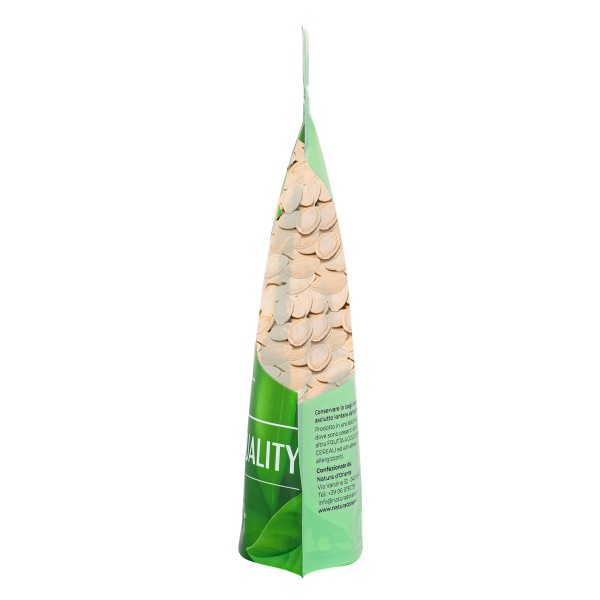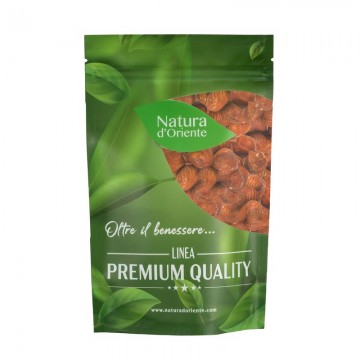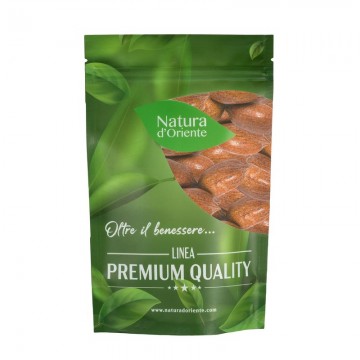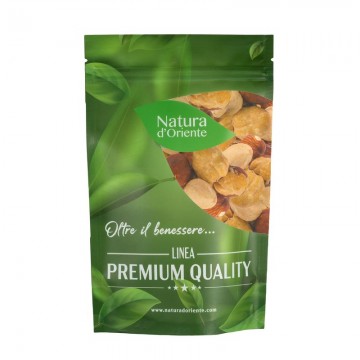Pumpkin seeds are the edible seeds of some plants of the cucurbit family.
Roasted and salted pumpkin seeds: properties and benefits
Pumpkin seeds have always been known for their deworming properties and properties that help the bladder in case of cystitis. From a nutritional point of view they are quite caloric even if not as much as walnuts and other dried fruit and have a good content of essential fats.
Nutritional values of pumpkin seeds
In the toasted and salted version, pumpkin seeds are composed of 2% water, 49% fat, 15% carbohydrates and 30% protein. < / strong> One hundred grams of pumpkin seeds give a calorie intake of 574 kilocalories.
As far as vitamins are concerned, niacin (B3) stands out with 4.43 mg. Among the mineral salts iron (8.07 mg), zinc (7.64 mg), manganese (4.49 mg), magnesium (550 mg) and phosphorus (1174 mg). The previous values represent: in the case of niacin 30% of the recommended daily dose, in the case of iron 60% and in the case of other minerals well over 100%.
Remarkable values, albeit lower than the percentage of the daily ration, are those of Riboflavin (vitamin B2) (0.13 mg), vitamin B9 (57 micrograms). Sodium (256 mg) and potassium (788 mg).
History and cultivation
The most popular varieties of pumpkins today (as we have already seen with the term pumpkin does not indicate a single species but a group of plants of the cucurbit family) are native to America, in Europe they were imported by the Spaniards in the 16th century. In the past, another cucurbit from India had been introduced in Europe, the lagenaria, known by the names of flask gourd, wine gourd, bottle gourd due to its elongated shape. Currently also in Italy the cultivated and most appreciated species are those of American origin. The precise origin of pumpkins on the American continent is not easy to establish, most likely it is in Mexico. What we do know is that in the American continent domestication dates back to very remote times making them among the first plants to have been domesticated, we even speak of the period between 7500 and 5000 BC. In the North American continent they play an important role in tradition, the pumpkin pie is part of the traditional menu for Thanksgiving and the use of pumpkins for decorative Halloween lanterns is known. Despite the North American origin of the pumpkin and the place it has in the tradition of that country, the USA does not appear in the top four world producers of pumpkins. With 680 thousand tons produced in 2017, pumpkin is one of the most widespread crops in the USA, but the data on world production in 2018 see: China with 8.1 million tons, India with 5.6, Ukraine with 1.3 and Russia with 1,2.
Pumpkin seeds in the diet
As anticipated, pumpkin seeds have been used in traditional medicine for their vermifuge properties due to the action of an amino acid called cucurbitin and for anti-inflammatory properties in bladder diseases (cystitis). For the rest, what can be deduced from the nutritional values is valid, even in small quantities (always attentive to calories!) They can be an important source of some mineral salts and some vitamins, as well as valuable for the antioxidant capacity of fatty acids.
Plants and fruit
As we said pumpkins are part of the cucurbit family, which contains the beauty of 95 genera and 965 species, many are annual herbaceous plants, but there are also trees and lianas and thorny shrubs. This large botanical family is the one that contains the most species of food interest. Pumpkins native to North America are part of the cucurbit genus, most of the species are climbing plants. After all, the word cucurbitacea derives from the Sanskrit corb which means to twist or crawl and in fact the characteristic of this family are the climbing or crawling branches on the ground with an angular or twisted appearance. Returning in particular to the species of the genus cucurbita, that is the pumpkins, they have orange or yellow flowers. The female flowers produce the fruit and the male flowers the pollen and pollination occurs by means of insects.
Using pumpkin seeds in the kitchen
If the pumpkin is called the “pig of the povyou were "(or in a modern way maybe we could call it" the pig of vegetarians ") there is a reason, just as it happens for pigs, you don't throw anything away, you eat the flowers, you eat the fruit, you eat the seeds and give seeds themselves are obtained an oil widely used in Central Europe both for dressing salads and for cooking. Pumpkin seeds can also be used in tasty dishes . We chose a rice salad.
Brown rice salad with salted roasted pumpkin seeds
INGREDIENTS
- Brown rice 320 gr
- Baby zucchini 200 gr
- Carrots 160 gr
- Cherry tomatoes 200 gr
- Fresh broad beans to be shelled 450 gr
- Shelled pumpkin seeds 20 gr
- Pitted Taggiasca olives 50 gr
- Chives to taste
- Extra virgin olive oil 30 gr
- Salt to taste
- Black pepper to taste
Preparation
1) Place a large pot full of water on the stove and bring to a boil.
2) Pour in the rice 1 and cook for 30 minutes over medium heat.
3) In the meantime prepare the dressing:
3.1) Shell the beans and remove the skin from each seed. If you use beans that have already been shelled, you must still remove the outer skin (in the case of beans that have already been shelled, you will need about 70 grams)
3.2) Wash the courgettes, trim them and then grate them with a grater with large holes
3.3) Same thing with carrots, first peel them and then trim and grate them.
3.4) Wash the cherry tomatoes and cut them into quarters
3.5) Chop the chives.
4) Collect all the vegetables in a bowl and add the pumpkin seeds and the pitted Taggiasca olives.
5) Season with olive oil, salt and pepper, mix and set aside.
6) Once the brown rice is cooked, drain it with a narrow mesh strainer.
7) Pour the rice into a bowl and immediately add the olive oil to prevent it from sticking and allow it to cool completely.
8) When the rice has cooled, add the vegetable dressing and mix to mix everything.
The rice salad can be stored in the fridge in an airtight container for 2 or 3 days.













 No reward points for this product.
No reward points for this product.















